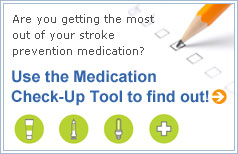|
|
 |
|
|
 |
 |
 |
 |
 |  | Why stroke risk reduction is so important |
|  |  |  | Understanding your stroke risk |
|  |  |  | How to reduce your risk of stroke |
|  |  |  | Working with your doctor |
|  |
|
 |
Every year, over 50,000 Canadians have a stroke. Will you be one of them? Find out if you are at risk of stroke, how a stroke could affect your life, and what you can do to reduce your risk of a stroke.
|
 |
|
|
 | | Stroke Risk Reduction resources |  |  |  | Related conditions |
|  |  | Related medications |
|  |  | Support groups |
|  |  |  | Health tools |
|  |  | Tests and procedures |
|  |  | Health articles |
|  |
|  |
|
|
|
 |
I want to learn more about Stroke risk reduction
I have atrial fibrillation (AFib) and want to learn more about stroke risk reduction
I have high blood pressure and want to learn more about stroke risk reduction
I have high cholesterol and want to learn more about stroke risk reduction
I have diabetes and want to learn more about stroke risk reduction
I have had a stroke or TIA ("mini-stroke") and want to reduce the risk of another stroke
< Back to Stroke Risk Reduction homepage

Talking to your doctor
Working with your doctor is an important part of managing your risk of stroke. Be prepared and learn how to talk to your doctor.
What can I do to reduce my stroke risk?
About 300,000 Canadians are living with the after-effects of a stroke,such as paralysis, vision problems, and difficulties with memory and thinking. But this doesn't have to be your story. Learn how you can reduce your stroke risk:
Get a treatment plan for your diabetes
Talk to your doctor
about a treatment plan to manage your diabetes.
Your treatment plan may involve
medications and healthy lifestyle changes. It's very important to follow the treatment plan your doctor recommends. If you have any questions or concerns, talk to your doctor.
Some people have other medical conditions that put them at risk of stroke. Talk to your doctor to learn more about your stroke risk and how to reduce your risk.
Live a healthy lifestyle
A few simple lifestyle changes can help you manage your diabetes and cut your stroke risk:
| Healthy lifestyle change |
What to aim for |
How to make it happen* |
| Eat healthy (good nutrition) as directed by your doctor |
Each day, try to eat:
- 7-10 servings of fruits and vegetables
- 6-8 servings of grains (with at least half of these from whole grain products)
- 2-3 servings of low-fat dairy products
- 2-3 servings of lean meat or meat alternatives (such as tofu)
Don't eat too much sodium. Aim for:
- age under 50: 1500 mg/day
- age 50-70: 1300 mg/day
- age over 70: 1200 mg/day
|
- Buy whole-grain bread instead of white.
- Add berries to your morning cereal, carrot sticks to lunch, or a salad to dinner.
- Whenever you would usually drink pop or juice, drink water instead.
- Use healthy snacks such as precut fruit and veggies and salad in a bag.
- Cook up a large batch of healthy food on the weekend, then freeze it in meal-sized portions for the week.
- Consult your doctor before making any changes to your diet.
|
| Exercise as directed by your doctor |
Ask your doctor how much activity and what types of exercise are safe for you. |
Check with your doctor before starting to exercise.
If your doctor gives you approval to exercise, start slowly - even 10 minutes of activity is enough to get started. Then gradually work your way up to longer exercise times:
- Today, after dinner, put on some comfortable shoes and walk around the neighborhood.
- Park a bit further from work or shopping.
- Do more gardening and physical household chores (such as vacuuming).
|
| Reach a healthy weight as directed by your doctor |
Aim for:
or
- waist size of less than 80 cm (31.5 inches) for women or less than 94 cm (37 inches) for men
|
- Try eating healthy and exercising (see above) to lose weight safely.
- Consult your doctor before making any changes to your physical activity or diet.
|
| Use alcohol in moderation as directed by your doctor |
- Limit yourself to no more than 2 drinks a day, to a maximum of 10 drinks per week for women, and no more than 3 drinks a day, to a maximum of 15 drinks per week for men.
(If you have liver disease, check with your doctor to find out your maximum recommended alcohol consumption.)
|
- Keep track of your drinking for a week to see if you're over the limit. One drink is:
- 341 mL (12 ounces) beer
- 142 mL (5 ounces) wine
- 43 mL (1.5 ounces) spirits
- Cut back if you are over the limit. If you are having trouble, talk to your doctor.
|
| Quit smoking as directed by your doctor |
Quit smoking and avoid second-hand smoke. If you are a non-smoker, do not start smoking. |
- When you're ready to quit, ask your friends and family to help, and speak to your doctor or pharmacist about options to help you quit.
|
| Tame your stress as directed by your doctor |
Understand and control the sources of stress in your life. |
- Make a list of things that make you feel stressed.
- Focus on the things that cause you the most stress, and think of ways to avoid or manage them. Try exercising (helps relieve stress), talking to a friend, taking breaks, using humour, delegating to someone else, or just saying "no."
- Consult your doctor for assistance with stress management.
|
| Have regular medical check-ups as directed by your doctor |
Have regular medical check-ups to make sure your diabetes is under control and to screen for other conditions that can increase your risk of stroke, such as high blood pressure, high cholesterol, or atrial fibrillation.† |
- Ask your doctor for an appointment card. Or, better yet, carry an organizer with you to your doctor's appointment and put the appointment in your calendar as soon as it is made.
- Ask your doctor how often you need to have medical check-ups.
|
*These lifestyle suggestions may not be appropriate for everyone. Check with your doctor to find out which lifestyle changes you should make to reduce your risk of stroke.
†This is not a complete list of all medical conditions that can increase your risk of stroke; speak with your doctor for more information.
Use diabetes medications as directed
What medications are available?
There are many different medications to control diabetes. The choice of medication will be based on the type of diabetes you have and whether you have other medical conditions.
People with type 1 diabetes are treated with insulin. There are different types of synthetic insulin, and they all work by replacing the insulin that used to be made by the body.
People with type 2 diabetes are treated with oral medications and may also need insulin. Some types of oral medications for diabetes include:
- alpha-glucosidase inhibitors: These lower blood sugar after meals by blocking an enzyme in the intestine that normally breaks down complex carbohydrates (e.g., those found in bread) into glucose. This slows down the rate at which the body absorbs glucose from foods, which gives the body more time after meals to produce enough insulin to handle the glucose.
- biguanides: These reduce glucose production in the liver and increase glucose use in the muscles. Both of these actions help lower blood sugar levels.
- dipeptidyl peptidase-4 inhibitors (DPP-4s): These help to increase insulin production and reduce the amount of sugar made by the body, leading to lower blood sugar levels.
- meglitinides: These cause the body to make more insulin, leading to lower blood sugar levels.
- sulfonylureas: These cause the body to make more insulin, leading to lower blood sugar levels.
- thiazolidinediones:These increase the body's sensitivity to insulin. This helps the body take up sugar from the blood and use it more effectively in body cells, which lowers blood sugar.
Some people with diabetes may also be treated with a type of non-insulin injectable medication called glucagon-like-peptide 1 (GLP-1) agonists. This type of medication works by helping the body release more insulin when blood sugar levels are high, which helps improve blood sugar control.
How are they used?
Diabetes medications are used in combination with lifestyle changes to lower your blood sugar to a healthy level.
The usual blood sugar targets are:
- fasting blood glucose (blood sugar levels before a meal): 4.0 mmol/L to 7.0 mmol/L
- 2-hour postprandial glucose (blood sugar levels 2 hours after a meal): 5.0 mmol/L to 10.0 mmol/L
- hemoglobin A1C (a measure of blood sugar control over the last 3 months): 7.0% or less
What are the risks of these medications?
These medications may cause side effects, such as:
- alpha-glucosidase inhibitors: gas, diarrhea, abdominal pain or discomfort, nausea, swelling or jaundice
- biguanides: nausea, diarrhea, stomach upset, decreased appetite, bloating, gas, metallic taste, lactic acidosis (a buildup of lactic acid in the blood)
- DPP-4s: serious allergic reactions (e.g., hives, rash, swelling of face or throat), runny or stuffy nose, sore throat, constipation, headache, kidney problems, inflammation of the pancreas, low blood sugar if combined with other diabetes medications
- GLP-1 agonists: nausea, vomiting, diarrhea, headache, heartburn, feeling jittery, inflammation of the pancreas, injection site reaction, low blood sugar if combined with a sulfonylurea
- insulin: low blood sugar, serious allergic reactions (e.g., hives, rash, swelling of face or throat), buildup of fatty lumps under the skin near the injection site (if the same site is used frequently)
- meglitinides: low blood sugar; high blood sugar; vision changes; abdominal pain; nausea; vomiting; constipation; sudden, severe headache or worsening of headache; dizziness; fatigue or increased sweating
- sulfonylureas: low blood sugar, headache, increased skin sensitivity to sunlight, dizziness, skin rash or itching, diarrhea, abdominal pain, nausea, leg swelling, unexpected weight gain, liver problems (yellowing of skin/eyes)
- thiazolidinediones: weight gain, low blood sugar if you are taking the product in combination with another diabetes medication, fluid retention, increased risk of broken bones, liver problems, heart failure or fluid accumulation in the lungs
This is not a complete list of all possible side effects. Talk to your doctor or pharmacist for full information on side effects of a particular medication.
How can I get the most from my medication?
- Talk to your doctor to make sure you know how to use your medication. Ask your doctor if there are any special instructions for your medication such as avoiding certain medications or foods, and whether you need any routine monitoring or testing while you are on the medication.
- Take your medication as recommended by your doctor. If you find that you miss doses of medication or scheduled medical tests, talk to your doctor or pharmacist for help.
- Call your pharmacy for a refill before you run out of medication.
- If you have any questions or concerns about your medication, ask your doctor or pharmacist for help.
- Use the Medication Check-Up tool to make sure you're getting the most out of your medication and see whether it's time to talk to your doctor about your medication.
 |
|
 |
|












